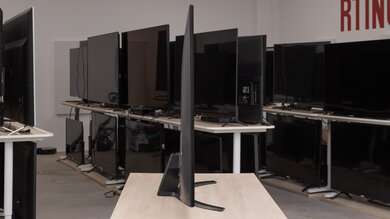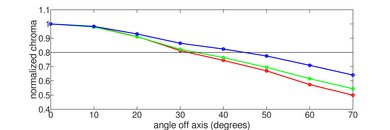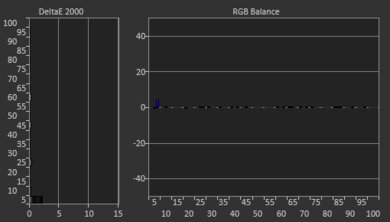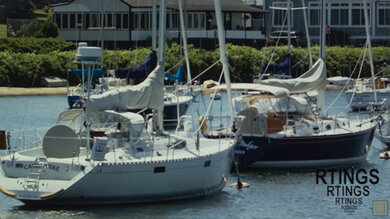The LG NANO81 is a decent overall TV with an IPS panel. It's a very simple TV that's limited on extra features as it doesn't support any variable refresh rate (VRR) technology or Dolby Vision. It has wide viewing angles, so it's a good choice for watching the big game with a lot of friends. Sadly, people who enjoy watching movies in the dark may be disappointed with its low contrast ratio, bad local dimming feature, and uniformity issues. It's a good choice for console gamers because the response time is decent and the input lag is incredibly low. Overall, it's a fairly well-built TV with an excellent design and a premium-looking center-mounted stand.
Our Verdict
The LG NANO81 is a decent TV for most uses. With its IPS panel, it's a good choice for watching sports with a group of friends or using it as a PC monitor. It has a low contrast ratio, poor black uniformity, and its local dimming feature is bad, so watching movies in the dark isn't a good choice. It doesn't have any VRR support and it has a 60Hz refresh rate, but casual gamers should appreciate the incredibly low input lag and decent response time.
- Wide viewing angles.
- Excellent reflection handling.
- Incredibly low input lag.
- Poor dark room performance.
- Doesn't get very bright.
- No VRR support.
The LG NANO81 is mediocre for watching movies. It has an IPS panel that has a low contrast ratio, and its local dimming feature is bad. It also has poor black uniformity, so dark scenes don't look good. Luckily, it upscales lower-resolution content well and removes judder from 24p sources like native apps.
- Removes judder from native 24p sources.
- Poor dark room performance.
Very good for TV shows. The LG NANO81 has excellent reflection handling, but it doesn't get very bright, so you should avoid placing it in really bright rooms. It has wide viewing angles and it upscales 720p content, like from cable boxes, without any issues. LG's WebOS platform also has a great selection of apps available to download.
- Wide viewing angles.
- Excellent reflection handling.
- Upscales lower-resolution content well.
- Doesn't get very bright.
- Disappointing built-in speakers.
The LG NANO81 is good for sports. It has wide viewing angles if you watch games with a big group of friends. It has a decent response time, so fast-moving content doesn't have a lot of motion blur, and there's also almost no dirty screen effect. You should avoid watching sports in really bright rooms as it doesn't get very bright, but it has excellent reflection handling.
- Wide viewing angles.
- Excellent reflection handling.
- Decent response time.
- Doesn't get very bright.
- Disappointing built-in speakers.
The LG NANO81 is good for video games. It doesn't have any gaming features like VRR support and it's limited to a 60Hz refresh rate. Regardless, it has a decent response time and an incredibly low input lag. It also upscales 1080p content very well, so it's a good TV for console gaming.
- Excellent reflection handling.
- Incredibly low input lag.
- Decent response time.
- Poor dark room performance.
- No VRR support.
Disappointing for HDR movies. The LG NANO81 doesn't support Dolby Vision, its color gamut is only decent, and it doesn't get bright enough to make highlights pop in HDR, so it doesn't look different from SDR content. It also has a low contrast ratio, a bad local dimming feature, and poor black uniformity. On the upside, it removes judder from native 24p sources.
- Removes judder from native 24p sources.
- Poor dark room performance.
- Doesn't get very bright.
- Somewhat limited color gamut.
The LG NANO81 is okay for HDR gaming, mainly due to its good gaming performance. It has an incredibly low input lag and a decent response time, but HDR content doesn't look good. Its color gamut is a bit limited and it doesn't get bright enough to bring out highlights. Also, it's limited to a 60Hz refresh rate and it doesn't have VRR support.
- Incredibly low input lag.
- Decent response time.
- Poor dark room performance.
- Doesn't get very bright.
- Somewhat limited color gamut.
The LG NANO81 is a great choice to use as a PC monitor. It displays proper chroma 4:4:4, which is important for reading text. It has wide viewing angles, so it's a good choice to place in a meeting room. It's not the best TV to place in bright rooms, as even though it has excellent reflection handling, it doesn't get bright enough to combat glare.
- Wide viewing angles.
- Displays proper chroma 4:4:4.
- Excellent reflection handling.
- Incredibly low input lag.
- Doesn't get very bright.
Changelog
- Updated Jul 28, 2021: Added the real content local dimming videos.
- Updated Mar 01, 2021: Converted to Test Bench 1.6.
- Updated Jul 28, 2020: Review published.
- Updated Jul 23, 2020: Early access published.
Check Price
Differences Between Sizes And Variants
We tested the 65 inch LG NANO81 (65NANO81ANA) and we expect our results to be valid for the 55 inch (55NANO81ANA) and 75 inch (75NANO80UNA) models too. The 75 inch model in the U.S. and the Canadian models have a different stand, similar to the one on the LG NANO85 2020.
| Size | US | Canada | EU |
| 49" | - | 49NANO80UNA |
49NANO816NA |
| 55" | 55NANO81ANA | 55NANO80UNA |
55NANO816NA |
|
65" |
65NANO81ANA | 65NANO80UNA |
65NANO816NA |
| 75" | 75NANO80UNA | 75NANO80UNA | - |
If someone comes across a different type of panel or if their NANO81 doesn't correspond to our review, let us know and we'll update the review. Note that some tests such as the gray uniformity may vary between individual units.
The unit we reviewed was manufactured in April 2020 and you can see the label here.
Popular TV Comparisons

The LG NANO81 is a decent overall TV with an IPS panel, and if you tend to watch movies in the dark, there are better choices with a VA panel, like the Samsung TU8000. It performs worse than the LG NANO85 2020 and the LG NANO90, but this is expected since it's lower in the LG lineup. Also see our recommendations for the best 4k TVs, the best TVs for PC monitors, and the best LG TVs.
The LG NANO81 is better than the LG NANO80 2020. The NANO81 gets brighter, has much better reflection handling, and it has a local dimming feature, but it doesn't perform well. However, the NANO80 has a quicker response time and much better out-of-the-box color accuracy, but this may vary between units.
The Samsung TU8000 and the LG NANO81 are two very similar-performing TVs with different panel types. The Samsung has a VA panel that displays deeper blacks and has much better black uniformity. The Samsung also supports HDR10+ and has better built-in speakers. On the other hand, the LG has wider viewing angles, handles reflections better, and because of its IPS panel, has wider viewing angles.
The Sony X800H is slightly better overall than the LG NANO81. The Sony gets much brighter, it has wider viewing angles, much better out-of-the-box color accuracy, and it has better built-in speakers. However, lower-frame rate content stutters less on the NANO81 and it removes judder from native 24p sources.
The LG NANO90 2020 is much better the LG NANO81. The NANO90 has a higher 120Hz refresh rate and has variable refresh rate support. It also supports Dolby Vision, has a wider color gamut, better built-in speakers, and it gets brighter. On the other hand, the NANO81 has a lower input lag, it handles reflections better, and it also wider viewing angles.

We buy and test dozens of TVs yearly, taking an objective, data-driven approach to deliver results you can trust. Our testing process is complex, with hundreds of individual tests that take over a week to complete. Most of our tests are done with specially designed test patterns that mimic real content, but we also use the same sources you have at home to ensure our results match the real-world experience. We use two main tools for our testing: a Colorimetry Research CR-100 colorimeter and a CR-250 spectroradiometer.
Test Results

The LG 65NANO81ANA has an excellent design and looks a lot like the LG NANO85 2020 and the LG SM8600 in terms of its build and frame. It has the same center-mounted stand as the SM8600 that gives it a more premium look than the two-footed stand on the 85.
The center-mounted moon-shaped stand is mainly plastic, except for the base underneath the stand, which is metal. The center part that connects to the TV is plastic and doesn't hold the TV very well as there's a lot of wobble. Note that there's a 75 inch model available with a stand similar to the LG NANO85 2020.
Footprint of the 65" TV: 32.7" x 12.8".
The back is made out of a thin sheet of metal that almost feels plastic and it has a slightly-brushed textured finish to it. The back panel bends quite easily. Also, cable management is serviced through the stand, keeping your setup clean.
Decent build quality, very much like the LG SM8600. The stand wobbles a lot and the back panel has a lot of flex to it. Also, you can visibly see the screws and lines where the different parts of the TV are attached.
The contrast ratio is okay; it's actually better than most IPS panels we've seen, but blacks appear closer to gray when viewed in the dark. There's a local dimming feature that only slightly improves the contrast ratio. If you want a TV with a better contrast ratio, check out the Samsung Q60/Q60A QLED.
The LG 65NANO81ANA has a disappointing SDR peak brightness. This TV doesn't get very bright, not enough to combat glare in bright rooms. For the most part, its brightness remains consistent with varied content.
We measured the brightness after calibration in the 'Expert (Dark Mode)' Picture Mode, with Local Dimming on 'Medium', Backlight set to 'Max', and the Color Temperature set to 'Warm 2'.
If you don't care about image accuracy and want the brightest image possible, set the Picture Mode to 'Vivid' with the Local Dimming on 'High' and Backlight to 'Max'. We were able to get 504 nits on the 2% peak window test.
Update 07/28/2021: Added the real content local dimming videos.
The LG 65NANO81ANA has a bad local dimming feature. It has six edge-lit dimming zones and bright objects light up entire zones, so you can see where each zone starts and ends, which is distracting even during real content. Due to this issue, there are noticeable blooming and uniformity issues around subtitles and bright objects. On the upside, it doesn't crush scenes and objects transition between zones well. We recommended setting Local Dimming to 'Medium' as it's less distracting than on 'High'.
Update 07/28/2021: Added the real content local dimming videos.
The LG NANO81 has disappointing brightness in HDR. It doesn't get bright enough to make highlights pop the way they're supposed to, so HDR content doesn't look all that much different from SDR.
We measured the brightness before calibration in the 'HDR Cinema' Picture Mode with Local Dimming on 'Medium', Backlight set to 'Max', and the Color Temperature set to 'Warm 2'. The brightest the TV got was with these settings, as seen in the 2% peak window test.
The LG 65NANO81ANA has good gray uniformity. The edges of the screen are slightly darker, more so near the corners. There's also very minimal dirty screen effect in the center, which is great for sports fans. The uniformity is much better in near-dark scenes, except there's visible backlight bleed in the bottom right corner.
Bad black uniformity for the LG 65NANO81ANA. Without local dimming, there's clouding and backlight bleed in the bottom right corner, and the screen appears more blue than black. With local dimming, the uniformity is even worse, as the center cross lights up the two dimming zones in the center, and the left and right dimming zones are the only zones truly turned off.
Good viewing angles, which is expected from an IPS panel TV. It's better than other TVs in LG's 2020 LED lineup like the LG NANO90. The image remains accurate when viewing from the side, ideal for a wide seating arrangement.
The LG 65NANO81ANA has alright out-of-the-box color accuracy. The colors are fairly accurate but the color temperature is very cold, giving the image a blue-ish tint. The white balance is off and the gamma doesn't follow the curve well, as most scenes appear darker than they should. If you want a similar TV with much better accuracy out of the box, check out the Sony X80J.
The LG 65NANO81ANA has outstanding color accuracy after calibrating. Any remaining inaccuracies are difficult to spot without the aid of a colorimeter and the gamma follows the target almost perfectly. The color temperature is cold when displaying an image with 5% and 10% stimulus levels, which affects the scoring for the color temperature. The temperature is closer to the 6500K target with all the other stimulus levels we tested.
You can see our recommended settings here.
Decent color gamut. It has impressive coverage of the DCI-P3 color space used in most HDR content, but it has limited coverage of the wider Rec. 2020 color space.
For the most part, the EOTF follows the curve fairly well until it rolls off, except most scenes are slightly too bright. In 'Game' mode, it performs exactly the same, as you can see in the here.
If you find HDR too dim, set Local Dimming to 'High', Dynamic Contrast to 'Medium' and enable the Dynamic Tone Mapping. The image is noticeably brighter as you can see the EOTF here.
Mediocre color volume. Due to its low contrast ratio and limited color gamut, the LG 65NANO81ANA doesn't display colors at different luminance levels well, and it can't display dark, saturated colors.
The LG 65NANO81ANA has good gradient handling. There's noticeable banding in all colors, especially with dark green and gray. In real content, enabling Smooth Gradiation helps smooth out gradients, and set it to 'Low' if you don't want to lose too much detail.
There are no signs of temporary image retention, even immediately after displaying our high-contrast static test image for 10 minutes, which is great.
Although some IPS panels can suffer from temporary image retention, this doesn't appear to be permanent as seen in our long-term test.
The LG 65NANO81ANA has a decent response time, slightly worse than the LG NANO85 2020, which has a 120Hz refresh rate. There's overshoot in darker transitions and some motion blur with fast-moving content. If you want something with a bit better response time, check out the LG NANO80.
Unfortunately, this TV doesn't have a black frame insertion feature to improve the appearance of motion. The backlight flickers at 120Hz in most modes.
The LG 65NANO81ANA interpolates motion up to 60fps, known as the 'Soap Opera Effect'. It looks decent overall and smooths everything out in slower scenes, but it doesn't stop interpolating in action-packed scenes, causing visible artifacts.
See our settings page for the motion interpolation settings.
Due to the TV's slower response time, there's not much stutter on this TV when displaying lower frame rate content. This is similar to the Samsung TU8000.
The LG 65NANO81ANA can remove judder from native 24p content, such as from native apps, but like most 60Hz TVs, it can't remove 24p judder from 60p/i signals. To remove judder, enable Real Cinema.
The LG 65NANO81ANA doesn't support any variable refresh rate technology.
The LG 65NANO81ANA has an incredibly low input lag, even lower than the LG NANO85 2020 and LG NANO90. You need to be in 'Game' mode to achieve the lowest input lag possible, and the TV has an 'Auto Low Latency Mode' that automatically switches to 'Game' mode when a compatible device is connected. To enable it, turn on the Instant Game Response setting.
All common resolutions at 60Hz are supported on this TV. It displays proper chroma 4:4:4, which is important for reading text if you use this TV as a PC monitor. To do this, set the input icon to 'PC'. Also, enable HDMI Ultra HD Deep Color to achieve full bandwidth.
Note that we were able to input 1080p @ 120Hz and 1440p @ 120Hz signals, but at 1080p it skips frames, and at 1440p, it doesn't properly display an image, so it's not useable.
Unlike the LG NANO85 2020, the LG 65NANO81ANA doesn't support Dolby Vision.
LG dropped its DTS decoding from their TVs in 2020, so the LG 65NANO81ANA only supports Dolby Digital via ARC and optical. We experienced a bug with ARC during testing, as there was no sound coming out until we restarted the TV. We don't know if this was a one-time issue or not, so if you experience the same issue, let us know in the comments below.
Disappointing frequency response, similar to 2019's LG SM8600. It can't produce a deep bass and it doesn't get very loud either, so it's not ideal for noisy environments. There's a room correction feature through the 'AI Service' menu.
The LG 65NANO81ANA has decent distortion performance. There's minimal total harmonic distortion at moderate listening levels, but it gets more noticeable at its max volume.
The LG 65NANO81ANA runs on WebOS, which is easy to use and fairly smooth to navigate. We did experience issues during testing, because as we were navigating the menus with the scroll wheel and the remote pointer direct to the TV, the menu would get stuck and we weren't able to select anything lower in the list than where we already were.
The LG 65NANO81ANA uses the same LG Magic Remote as other LG TVs. You can use it like a traditional remote or point and press. There are shortcut buttons to Netflix and Amazon Prime Video and it has built-in voice control. You can ask it to change inputs, open apps, search for content within specific apps, change brightness, and ask for the weather conditions. You can also use it as a universal remote with other devices, even if they don't support CEC.

















































